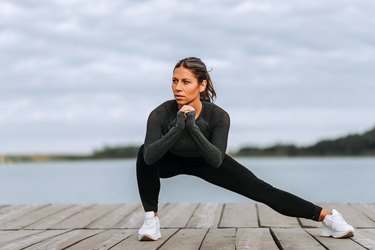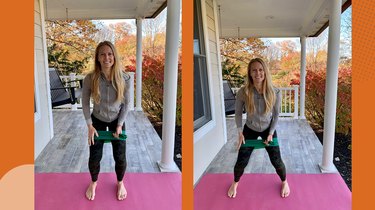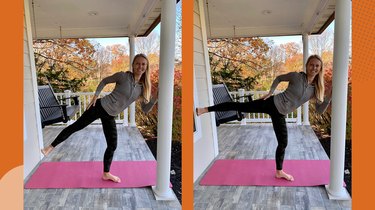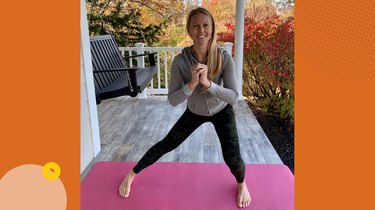
Odds are, exercises like lunges and squats, which target your gluteus maximus, monopolize your butt workouts. Yep, the biggest muscle in your body gets all the glory and attention. But you shouldn't neglect your other glute muscles, in particular your gluteus medius and hip abductors (aka, the side booty).
Heathy hip abductors keep your pelvis, lower back and knees strong and stable, Erica Ziel, personal trainer and host of The Core Connections Podcast, tells LIVESTRONG.com.
Video of the Day
Video of the Day
When your abductors aren't structurally solid, you can experience pain in your knees, lower back and hips because your body is compensating by using other muscles to stabilize itself, Ziel explains. "The longer this goes on, the tighter and stronger the compensating muscles become and the weaker the lateral hips become."
All this to say, it's smart to pay attention to your side butt during your workouts. Before you start cranking out clamshells or fire hydrants, though, read the list below to learn which hip abductor exercises are a waste of your workout time and which can strengthen these smaller (yet significant) glute muscles.
1. Side-Lying Leg Lift
While side-lying leg lifts with a small, controlled range of motion can effectively strengthen the abductors, most people perform them incorrectly, rendering the move useless, Ziel says.
Often, exercisers speed through leg lifts, kicking their leg toward the ceiling, but this large range of motion only over-activates the hip flexors and possibly overextends your lower back, she says.
"In our days of sitting way too much, it's important to skip exercises that over-activate hip flexors, as this can contribute to even more imbalances in your pelvis and ultimately cause back and hip pain," Ziel says.
Tip
If you still want to give the side-lying leg lift a try, lift with muscle (not momentum) and control your range of motion.
You might also try performing them with your knee and toes pointed slightly toward the ground, as this position can be helpful for engaging your abductors, Ziel says.
2. Clamshell
The problem with clamshells is, just like with side-lying leg lifts, people often perform the exercise incorrectly with poor form, i.e., too much bend in the knees and excessive range of motion.
"When done in this way, clamshells can pull on your back and over-activate your hip flexors, bypassing your abductors completely," Ziel says.
Tip
Not ready to give up clamshells completely? “Keep your legs a little straighter, as this helps you to stay out of your lower back and find the movement from your outer hips,” Ziel says.
The other option is trying clamshells with and without your heels touching to see which variation best activates your abductors (it’ll be different for every person).
3. Fire Hydrant
Similar to clamshells, exercisers have the tendency to overuse their lower back and hip flexors to execute fire hydrants, Ziel says.
And like side-lying leg lifts, many people power through fire hydrants, swinging their leg too fast with too large a range of motion and without properly engaging the abductors.
4. Seated Abductor Exercise
Abductor machines at the gym score poorly on targeting your lateral glute muscles, since they can easily over-activate hip flexors.
"When in a seated position, it's easy to force a motion and use the wrong muscles," says Ziel, adding that seated abduction with resistance bands run into the same issue.
Plus, machine-based exercises don't create stability (or have the same level of functionality) for your body that other movements do, Ziel says.
6 Exercises You Should Do Instead
These six hip abductor exercises will help you build a stronger gluteus medius and prevent pain and injuries in your lower-body joints.
1. Lateral Band Walk

- Place a resistance band around your thighs just above your knees.
- Keep your feet parallel to each other as you lower into a squat and brace your core.
- Lead with the right leg as you walk step the right, then step in with the left, bringing your legs back to a squat.
- Do this for a couple of reps to the right, then repeat going to the left.
- Aim for 10 to 20 reps total.
Tip
Lateral band walks fire up your side booty as well as many other leg and core muscles, Ziel says.
“It’s important to find the range of motion that works for your body where you can feel the outer hips working and not your lower back or hip flexors,” Ziel says. Avoid tucking your butt under or squatting too deeply, she says.
2. Prone Frogger Leg Lift

- Lie on your stomach, rest your head in your hands and spread your legs, so your knees are positioned toward the sides of your mat.
- Bend your knees and bring your heels together.
- Exhale as you brace your core, press your heels together and reach your heels toward the sky. Keep in mind your thighs may not leave your mat, but you’ll feel your abs, outer hips and glutes working to try and lift your legs.
- Inhale as you lower your legs back to your mat (or release the muscle).
- Repeat for 10 reps.
Tip
These will make your glutes sizzle. “As with all abductors exercises, you’ll want to continue to keep your range of motion small and controlled as you move slowly through each repetition to avoid your lower back doing the work,” Ziel says.
3. Standing Single-Leg Lift

- Using a countertop or chair for stability, stand tall, balancing on your right leg.
- Exhale as you slowly hinge your upper body toward the right while extending your left leg to your side.
- Exhale as you push through your heel, lifting your leg away from your body and up toward the sky, only going as high as you can without engaging your lower back.
- Inhale as you lower your leg with control.
- Repeat for a total of 10 to 20 reps on each side.
Tip
Standing single-leg lifts work your abductors while strengthening your core and creating stability and strength in your hips and pelvis, Ziel says.
When performing these, aim for a controlled movement with a limited range of motion to ensure you don’t overuse your lower back.
4. Lateral Lunge Pulse

- Stand with feet together and hands clasped in front of your chest.
- Take a large step out to the right, sinking your hips back and bending your right knee. Keep your left leg straight but not locked, with both feet pointing forward.
- Exhale as you press up a couple of inches.
- Inhale as you lower back down with control.
- Repeat for a total of 10 slow pulses on one side, then switch legs.
Tip
Your hips will feel the burn with these lateral lunge pulses. “Keep your range of motion small so that your outer thigh does the work and not your hip flexors or lower back,” Ziel says.
5. Medial Squat Pulse

- Standing with your feet shoulder-width apart, rotate your feet toward each other (start with less rotation in the beginning and increase with practice).
- Pressing your heels into your mat and away from each other, inhale as you slowly lower into a shallow squat (avoid going too low).
- In this position, do 10 small pulses.
Tip
Medial squat pulses may feel slightly awkward and look a little funny, but they're “a very efficient way to engage and strengthen your abductors while also balancing your sacrum and pelvis,” Ziel says.
“If you feel stress in your lower back, adjust your range of motion to be even smaller, engage your core more or move your legs so they are parallel instead of rotated in,” she says.
6. Side Plank Dip

- Lie on your side, elbow in line with your shoulder and your feet stacked (or staggered).
- Exhale, reaching long through your legs, engaging your hips and mid-back and bracing your abdominals as you lift your hips up off your mat into a side plank.
- Inhale as you slowly lower your hips a couple of inches toward the floor.
- Exhale as you press your hips up, keeping your legs, hips, core and mid-back engaged.
- Repeat for 10 to 20 reps on each side.
Tip
Side plank dips are a fun way to target your abductors and strengthen your obliques at the same time, Ziel says.